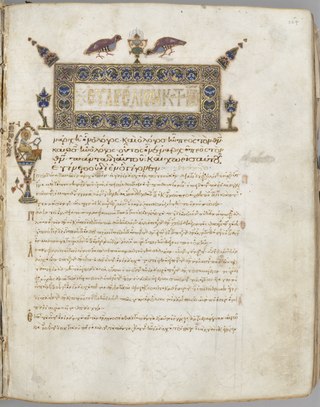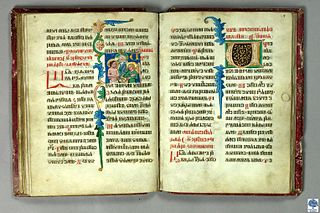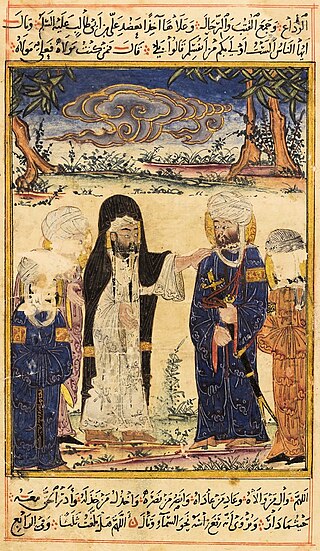
The Quran, also romanized Qur'an or Koran, is the central religious text of Islam, believed by Muslims to be a revelation from God. It is organized in 114 chapters, which consist of verses. In addition to its religious significance, it is widely regarded as the finest work in Arabic literature, and has significantly influenced the Arabic language.

An illuminated manuscript is a formally prepared document where the text is decorated with flourishes such as borders and miniature illustrations. Illuminated manuscripts include liturgical books such as psalters, courtly literature, and documents such as proclamations.

The Book of Fixed Stars is an astronomical text written by Abd al-Rahman al-Sufi (Azophi) around 964. Following the translation movement in the 9th century AD, the book was written in Arabic, the common language for scholars across the vast Islamic territories, although the author himself was Persian. It was an attempt to create a synthesis of the comprehensive star catalogue in Ptolemy’s Almagest with the indigenous Arabic astronomical traditions on the constellations. The original manuscript no longer survives as an autograph, however, the importance of tradition and the practice of diligence central to Islamic manuscript tradition have ensured the survival of the Book of Stars in later-made copies.

Saint Catherine's Monastery (Arabic: دير القدّيسة كاترين Dayr al-Qiddīsa Katrīn; Greek: Μονὴ τῆς Ἁγίας Αἰκατερίνης, officially the Sacred Autonomous Royal Monastery of Saint Catherine of the Holy and God-Trodden Mount Sinai, is a Christian monastery located in the Sinai Peninsula of Egypt. Located at the foot of Mount Sinai, it was built between 548 and 565, and is the world's oldest continuously inhabited Christian monastery.

Islamic calligraphy is the artistic practice of handwriting and calligraphy, in the languages which use Arabic alphabet or the alphabets derived from it. It includes Arabic, Persian, Ottoman, and Urdu calligraphy. It is known in Arabic as khatt Arabi, which translates into Arabic line, design, or construction.

Codicology is the study of codices or manuscript books. It is often referred to as "the archaeology of the book," a term coined by François Masai. It concerns itself with the materials, tools and techniques used to make codices, along with their features.

Xiao'erjing, often shortened to Xiaojing, is the practice of writing Sinitic languages—such as the Lanyin Mandarin, Zhongyuan Mandarin and Northeastern Mandarin dialects—or the Dungan language using the Perso-Arabic script. It is used on occasion by many ethnic minorities who adhere to Islam in China—mostly the Hui, but also the Dongxiang and the Salar—and formerly by their Dungan descendants in Central Asia. Orthography reforms introduced the Latin script and later the Cyrillic script to the Dungan language, which continue to be used today.

Beit Al Qur'an is a multi-purpose complex dedicated to the Islamic arts and is located in Hoora, Bahrain. Established in 1990, the complex is most famous for its Islamic museum, which has been acknowledged as being one of the most renowned Islamic museums in the world.
The Seljuk Empire, or the GreatSeljuk Empire, was a high medieval, culturally Turko-Persian, Sunni Muslim empire, established and ruled by the Qïnïq branch of Oghuz Turks. It spanned a total area of 3.9 million square kilometres from Anatolia and the Levant in the west to the Hindu Kush in the east, and from Central Asia in the north to the Persian Gulf in the south.

Jāmiʿ al-tawārīkh is a work of literature and history, produced in the Mongol Ilkhanate. Written by Rashid al-Din Hamadani at the start of the 14th century, the breadth of coverage of the work has caused it to be called "the first world history". It was in three volumes and published in Arabic and Persian versions.

The Remaining Signs of Past Centuries by Abū Rayhān al-Bīrūnī is a comparative study of calendars of different cultures and civilizations, interlaced with mathematical, astronomical, and historical information, exploring the customs and religions of different peoples.

The True Furqan is a book written in Arabic that tries to imitate the Qur'an while incorporating elements of traditional Christian teaching.

The Great Mosque of Sana'a is an ancient mosque in Sana'a, Yemen, and one of the oldest mosques in the world. The mosque is said to have been founded in the early Islamic period, suggested to be in 633. While the precise date of construction is unknown, the earliest recorded renovations occurred under Caliph al-Walid I in the early 8th century, implying a possible earlier date of construction. The mosque was reportedly built in part from spolia from the Himyarite-era Ghumdan Palace and from the Axumite Christian Church of al-Qalis that formerly occupied the site. The Great Mosque is the largest and most notable of over one hundred mosques in the Old City of Sana’a.
Ousmane Oumar Kane is a Senegalese Muslim scholar of Islamic studies. He holds the Prince Alwaleed Bin Talal Chair on Contemporary Islamic Religion and Society at the Harvard Divinity School and the Department of Near Eastern Languages and Civilization at Harvard University since July 2012.

The Khalidi Library is a library and archive in the Old City of Jerusalem. It was established in 1900, under Ottoman rule.

The Birmingham Quran manuscript is a single sheet of parchment on which two leaves of an early Quranic manuscript or muṣḥaf have been written. In 2015, the manuscript, which is held by the University of Birmingham, was radiocarbon dated to between 568 and 645 CE. It is part of the Mingana Collection of Middle Eastern manuscripts, held by the university's Cadbury Research Library.
Yasin Dutton is the Azman Hashim Senior Research Fellow at the Oxford Centre for Islamic Studies and Emeritus Professor of Arabic in the School of Languages & Literature at the University of Cape Town. His research interests include early Quranic manuscripts and both classical and modern Islamic law, with an emphasis on economic and environmental issues.

Arabic miniatures are small paintings on paper, usually book or manuscript illustrations but also sometimes separate artworks that occupy entire pages. The earliest example dates from around 690 AD, with a flourishing of the art from between 1000 and 1200 AD in the Abbasid caliphate. The art form went through several stages of evolution while witnessing the fall and rise of several Islamic caliphates. Arab miniaturists absorbed Chinese and Persian influences brought by the Mongol destructions, and at last, got totally assimilated and subsequently disappeared due to the Ottoman occupation of the Arab world. Nearly all forms of Islamic miniatures owe their existences to Arabic miniatures, as Arab patrons were the first to demand the production of illuminated manuscripts in the Caliphate, it wasn't until the 14th century that the artistic skill reached the non-Arab regions of the Caliphate.
Islamic manuscripts had a variety of functions ranging from Qur'anic recitation to Scientific notation. These manuscripts were produced in many different ways depending on their use and time period. Parchment (vellum) was a common way to produce manuscripts. Manuscript creators eventually transitioned to using paper in later centuries with the diffusion of paper making in the Islamic empire. When Muslims encountered paper in Central Asia, its use and production spread to Iran, Iraq, Syria, Egypt, and North Africa during the 8th century.

Makkah Al Mukarramah Library is a library near the Masjid al-Haram in Mecca, Saudi Arabia. Since it is believed to stand on the spot where the Islamic prophet Muhammad was born, it is also known as Bayt al-Mawlid.

















